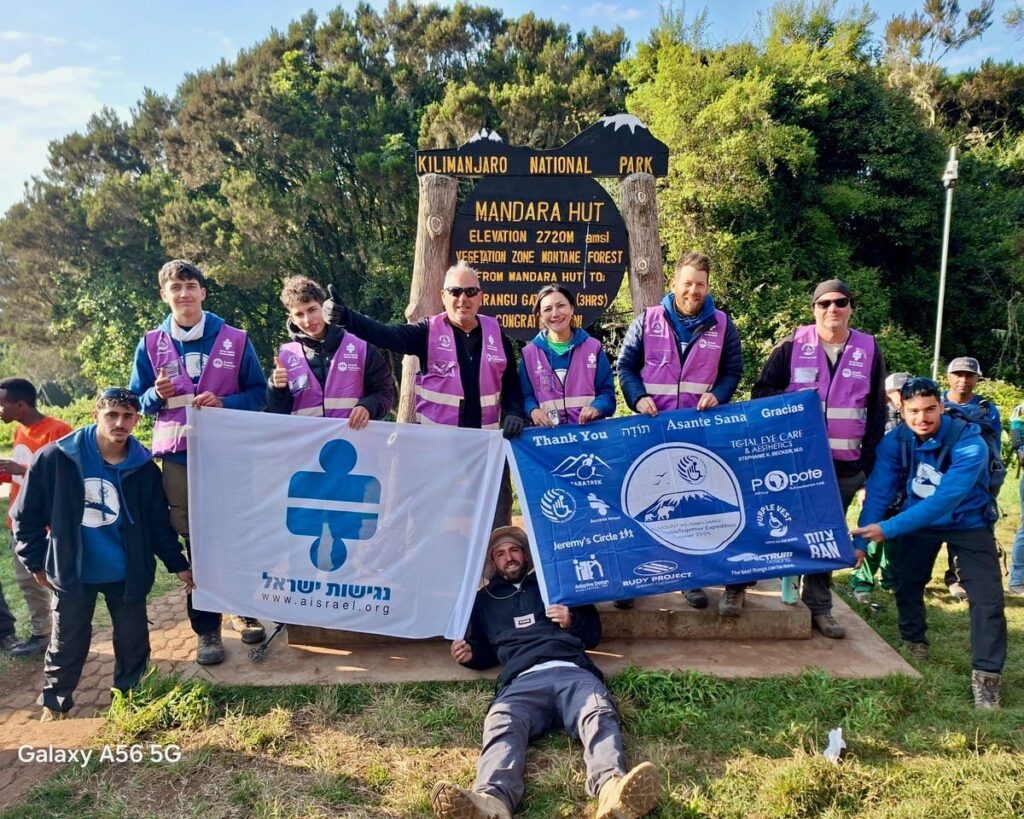By Howard Blas

Listen to this Article
Climbing Kilimanjaro, Africa’s tallest mountain, is an extreme challenge and a bucket list item for many people worldwide. Setting out for top of the 19,341 feet (5895 meters) mountain with 48 climbers—32 with a range of disabilities—and a record-breaking support team of 197 porters and guides sounds like an impossible proposition. But, with determination, nonstop singing, and dancing, extraordinary teamwork, and an adapted Paratrek Trekker vehicle, 39 climbers proudly stood at the “Roof of Africa” at sunrise on September 1, 2025. The remaining nine who set out on the expedition climbed well past the halfway point.
For context, an estimated 35% of people (usually nondisabled) who set out never make it to the summit. This is due, in large part, to the intense effect of altitude on the body, extremely long days on one’s feet walking through the five ecological climate zones, and the harsh cold and windy conditions one is sure to face on summit night.
The chances of reaching the summit, while certainly not guaranteed, are increased by investing in proper preparation, choosing a longer route which allows for acclimatization, picking a supportive team, and by having mental toughness—especially as one sets off at midnight, in the pitch dark, for the final multi hour ascent to the summit—in time to see the sun rising.
Israeli hiker, Omer Zur, is a rare person who has reached the top of Kilimanjaro three times. Had Zur simply climbed Kilimanjaro on his own, he would have had a nice story of perseverance and hard work to tell his friends. But that would be out of character. Zur is committed to inclusion and creating experiences and opportunities for everyone. For that reason, each of Zur’s climbs has been with people with a wide range of disabilities and support needs.
Zur’s “wiring” and inclusive inclination comes, in part, from growing up with a father who lived most of his adult life with quadriplegia, the result of war injury. Zur, who wanted his paralyzed father to join him on a multi-week hike in Turkey, created the Paratrek Trekker. The device, which evolved over time and continues to evolve, is a cross between a large tired wheelchair chair and a rickshaw, and it can handle extreme off-road hiking. It can navigate through rough and rocky terrain, steep inclines, narrow paths, sand, gravel and boulders. The Trekker is meant for a team including a person with a disability and helpers.
Zur’s most recent Kilimanjaro climb—August 28 to September 3, 2025—through the Accessibility Accelerator organization was the most ambitious and inclusive to date.
In the words of Jamie Lassner, Executive Director of Accessibility Accelerator, “This was not just another climb—it was a landmark in what adventure and inclusion can mean.” As Lassner watched the delegation set out on the climb, and as they returned a week later, he observed, “Together, they formed a tapestry of resilience, determination, and humanity. When the team stepped through the gates of Kilimanjaro National Park, they did so not simply as climbers but as a living demonstration that strength is magnified through diversity, and that the true summit lies in becoming a family united by trust, courage, and shared purpose. These climbers faced the mountain with grit, laughter, and unshakable spirit. They showed that disability doesn’t define limits—it redefines teamwork, reshapes joy, and turns struggle into triumph. In their songs, in their humor, and in their sheer determination, they rewrote what it means to endure as a united family, each with their arms outstretched to help others”.
Zur, ultimately responsible for the Trekkers and for the participants, reports playfully and with a certain seriousness, “Saying yes to lead a group like this was an act of almost madness!” He explains that this was the most diverse group he has led “People came from different cultures and countries, they ranged in age from 15 to 60, they were Jewish and non-Jewish, religious and secular, people on the autism spectrum, with PTSD.”
In highlighting the various disabilities and support needs—including physical, emotional and medical needs, Zur shares his honest initial thought about bringing this group to Kilimanjaro. “Bringing 50 people without disabilities to this mountain is crazy. So take these 50 people –almost no one does!”
Zur then shares a few strategies for getting himself—and the large delegation—up the mountain. “I kept reminding myself why we are doing this, I reminded myself to not look at the top but to take it one step at a time, and to not think of the group of 48, but as one person at a time, who each had their goal, mission, needs and disabilities who each came to this challenge.”
Tamara Morgan, 40, Community Partnerships Coordinator for Adaptive Designs Associates Association, Inc, set her sights on making it to the top of Kilimanjaro and looked forward to potentially becoming the first person in the world with Osteogenesis Imperfecta (brittle bone disease) to do so. Morgan grew up in New York City, and reports the she was always very active. “I never imagined climbing Kilimanjaro was possible NOT because of stamina or excitement, but because the equipment just wasn’t there.”
Morgan learned of Zur’s Trekker but at 3 feet 2 inches, she knew it would require major modifications. With her important feedback and input into customizing the Trekker—and with Zur’s willingness to work collaboratively to redesign the Trekker, she was one-step closer to achieving her ambitious goal.
Once the Trekker was modified with proper cushioning belts and straps, Morgan road tested the custom fitted Trekker in New York’s Central Park. It was even proudly on display at FIT (Fashion Institute of Technology)’s Adapt/Evolve exhibit which was on display in New York City until October 26, 2025. “I knew that once I had the right equipment, I could do it!” Morgan succeeded in becoming the first person with her condition to reach the top of Kilimanjaro. “You need mental toughness and a community encouraging one another,” Morgan notes. “It is a testament of endurance, collaboration and pushing yourself. It shows what is possible when you collaborate and allow accessibility everywhere.”
Morgan captures some of the not so obvious challenges a person faces in a Trekker for so many hours a day. “You are tilted 60 degrees back so you’re facing upward, toward the sky and sun. The sun is so intense so you get severe sunburn, no matter how much sunblock you use!”
She reports that perhaps the biggest motivator was singing of the guides and porters. “We were called Team Kimbo, or elephant. We sang most of the way up. It was a true motivator so we didn’t get bogged down by the physical and mental tiredness. We had to place our trust in them. It was a true collaboration between them and me. We had to have a dialogue. They were super receptive and wanted to make it as safe as possible. Mental fortitude got us through. Breaking bread together at the end of the day was also reinvigorating—we cheered, shared aches and pains and got to know each other.”
Andrew Hogan, though not a person with a disability, was drawn to adaptive sports after a chance encounter with adaptive rock climbing at his Washington, DC area gym. He subsequently became a visual guide for runners, bikers and swimmers and has even trained for marathons and triathlons to help his blind friends. While he attributes his experience as a college distance swimmer as useful, it is his “gift of gab” which helps athletes navigate unfamiliar settings. “It was curiosity about adaptive climbing which bought me in and wanting more access for my blind friends.”
Zur captures the human side of the delegation as he describes an important morning ritual. “When we gathered together each morning—it was crazy! Everyone was dancing and singing and no one wanted it to end. It was almost a religious, spiritual experience for the Tanzanian crew. They are about to work really hard. This is how they get powered up. And the whole group was with them. When that is going on, you can see who has and doesn’t have a disability.”
On Kilimanjaro, Hogan served as a guide to two blind climbers including Dr. Sachine Pavitran who reports, “Too often, we are told what we cannot do. This climb proved what the blind community—and anyone facing challenges—absolutely can do.” Hogan describes in incredible detail the techniques and tricks he utilized and figured out on the mountain. “”The more information you give, the better. It is good to be a talkative person if you want to be a visual guide,” he notes playfully. It also helps to be a good problem solver. He describes one blind hiker using a special blind hiking pole, while others benefited from a shared pole, which they both grasped as they climbed up the mountain
Hogan was also useful in helping educate the Tanzanian guides. While all hikers described the singing and dancing as a tremendous motivator and highlight of the climb, Hogan notes that, for blind climbers who really heavily on such senses as hearing, it could be overstimulating. As a result, the blind hikers either set out head of the group or waited in the back of the pack.
While the days climbing were taxing, Hogan enjoyed the many hours spent with the group at meals and hanging out. While Hogan grew up Episcopalian and is not particularly religious, he loved learning about the Jewish Sabbath from observant Jewish members of the group, and he enjoyed “lots of socializing” with the diverse group of participants. The always active Hogan describes the Kilimanjaro experience as “one of the best experiences of my life. There was the level of intensity of the feat, which was empowering and the human experience of meeting strangers all around the task and mission of making the mountain accessible. The climb felt never ending but not in a taxing way. When we were on the mountain, I felt more present than I had in years!”
Other members of the delegation included above-the-knee amputee, Boris Shtonda, who became the first in history to summit Kilimanjaro twice in one year—this time with his wife Anna, just months after their wedding, and nine teens from Jeremy’s Circle, an organization supporting children of families affected by cancer.
Lassner concludes, “This wasn’t just about only reaching the top of Kilimanjaro—it was about igniting a ripple of change that will echo in their countries and communities, as they return home as Ambassadors ready to fight for accessibility and equality with renewed fire. This was more than a climb—it was a movement. Together we stood on the highest point in Africa. Tomorrow, we will carry that spirit into every corner of the world. The summit belongs to everyone.”
